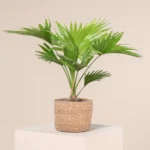Categories: Houseplants, Low-Maintenance Plants, Air-Purifying Plants, Succulents, Drought-Tolerant Plants
Snake Plant, Sansevieria, Mother-in-Law’s Tongue, indoor plants, air purifying, low maintenance
Snake Plant: Mastering the Care of This Hardy Houseplant

Introduction
The Snake Plant, scientifically known as Sansevieria trifasciata, is a hardy and versatile houseplant that has become a favorite among plant enthusiasts and novice gardeners alike. Known for its striking upright leaves and ability to thrive in various conditions, the Snake Plant is not just a pretty face – it’s also one of the best air-purifying plants you can have in your home. In this comprehensive guide, we’ll explore everything you need to know about caring for and enjoying this remarkable plant.
History and Origin
Native to tropical West Africa, the Snake Plant has been cultivated for centuries. It gained popularity in Europe during the Victorian era and has since become a staple houseplant worldwide. The genus Sansevieria is named after the Italian prince Raimondo di Sangro, Prince of Sansevero.
In its natural habitat, Snake Plants can grow quite large and are known for their ability to survive in arid conditions. This adaptability has made them excellent houseplants, capable of tolerating neglect and less-than-ideal conditions.

Plant Description
Snake Plants are characterized by:
- Tall, upright leaves that can grow 1-4 feet high or more
- Thick, waxy leaves with variegated patterns of green, yellow, or white
- A rosette growth pattern, often spreading via rhizomes
- Occasional small, fragrant flowers on mature plants (though blooming is rare indoors)
- Several varieties and cultivars with different leaf shapes and colors
Popular Varieties
- Sansevieria trifasciata ‘Laurentii’: Green leaves with yellow edges
- Sansevieria trifasciata ‘Black Gold’: Dark green leaves with gold edges
- Sansevieria cylindrica: Cylindrical leaves, often braided
- Sansevieria ‘Moonshine’: Pale silvery-green leaves
- Sansevieria trifasciata ‘Hahnii’ (Bird’s Nest Snake Plant): Compact, low-growing rosettes

Plant Care
Light Requirements
Snake Plants are incredibly adaptable to light conditions. They can tolerate low light but thrive in bright, indirect light. They can even handle some direct sunlight, though too much can scorch the leaves.
Watering Needs
These plants are drought-tolerant and prefer to dry out between waterings. Water thoroughly when the soil is completely dry, typically every 2-6 weeks depending on light and temperature. Reduce watering in winter.
Soil Requirements
Use a well-draining potting mix. A cactus or succulent mix works well, or you can add sand and perlite to regular potting soil to improve drainage.

Temperature and Humidity
Snake Plants prefer warm temperatures between 60-80°F (15-27°C). They can tolerate brief periods of cooler temperatures but should be protected from frost. They adapt well to average home humidity levels.
Fertilizer
Feed sparingly with a balanced, water-soluble fertilizer diluted to half strength once or twice during the growing season (spring and summer). Avoid fertilizing in winter.
Pruning and Maintenance
Pruning is generally not necessary for Snake Plants, but you can:
- Remove any yellow or damaged leaves at the base.
- Trim leaves to control height if desired.
- Divide overgrown plants to control size and propagate new plants.

Propagation
Snake Plants can be propagated in several ways:
- Division:
- Separate offsets or divide the rhizome during repotting.
- Ensure each division has roots and healthy leaves.
- Leaf cuttings:
- Cut a leaf into 2-3 inch sections.
- Allow cuts to callus for a day.
- Plant in moist, well-draining soil.
- Keep warm and lightly moist until new growth appears.
- Water propagation:
- Place leaf cuttings in water, ensuring the cut end is submerged.
- Change water regularly until roots develop.

Potting and Repotting
- Choose a pot with drainage holes.
- Repot every 2-3 years or when the plant outgrows its container.
- Snake Plants prefer to be slightly root-bound, so don’t rush to repot.
- Spring or early summer is the best time for repotting.
Air Purification Benefits
Snake Plants are renowned for their air-purifying qualities. They can:
- Remove toxins such as formaldehyde, xylene, and toluene from the air
- Convert CO2 to oxygen at night, making them excellent bedroom plants
- Help to regulate humidity in indoor spaces
Pests and Diseases
Common Pests
- Spider mites
- Mealybugs
- Scale insects
Treat infestations with insecticidal soap or neem oil.
Diseases
- Root rot (from overwatering)
- Leaf spot diseases
Prevent by avoiding overwatering and ensuring good air circulation.
Common Problems
- Yellowing leaves: Often indicates overwatering or poor drainage.
- Brown leaf tips: Can be due to underwatering, low humidity, or fluoride in tap water.
- Soft, mushy leaves: Usually a sign of overwatering or cold damage.
- Pale, faded leaves: May indicate too much direct sunlight.

FAQs
Are Snake Plants toxic?
Yes, they are mildly toxic if ingested. Keep away from pets and children.
How often should I clean the leaves?
Dust leaves with a damp cloth or shower the plant every few months to keep leaves clean and healthy.
Can Snake Plants be grown outdoors?
Yes, in USDA zones 9-11. They make excellent patio or garden plants in warm climates.
Why isn’t my Snake Plant growing?
Snake Plants are slow growers. Lack of growth could be due to insufficient light, poor nutrition, or being rootbound.
Tips for Success
- Less is more with watering – when in doubt, wait another day.
- Provide bright, indirect light for optimal growth.
- Use a pot with drainage holes to prevent water accumulation.
- Clean leaves occasionally to maintain their aesthetic appeal and health.
- Be patient – Snake Plants are slow growers but long-lived.
Quick Facts
| Attribute | Detail |
|---|---|
| Scientific Name | Sansevieria trifasciata |
| Common Names | Snake Plant, Mother-in-Law’s Tongue, Viper’s Bowstring Hemp |
| Native Region | Tropical West Africa |
| Plant Type | Succulent, evergreen perennial |
| Height | 6 inches to 8 feet, depending on variety |
| Light Needs | Low light to bright indirect light |
| Water Needs | Low, drought-tolerant |
| Humidity | Adaptable to average home humidity |
| Toxicity | Mildly toxic if ingested |
| Propagation | Division, leaf cuttings |
| Air Purification | Excellent, NASA Clean Air Study approved |

Conclusion
The Snake Plant is a testament to the beauty of simplicity in the plant world. Its striking appearance, coupled with its incredible resilience and air-purifying qualities, makes it an ideal choice for both seasoned plant enthusiasts and those just beginning their plant parenthood journey. Whether you’re looking to add a touch of green to a dim corner, purify the air in your bedroom, or simply enjoy a low-maintenance plant companion, the Snake Plant is an excellent choice. With the care tips and information provided in this guide, you’re well-equipped to help your Snake Plant thrive and enjoy its beauty for years to come. Happy planting!
Views: 0











